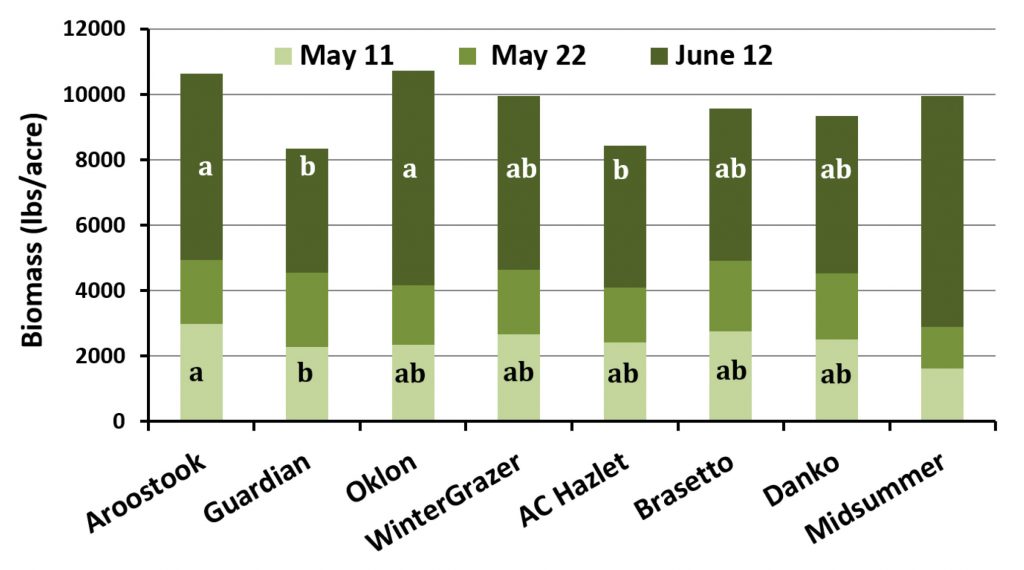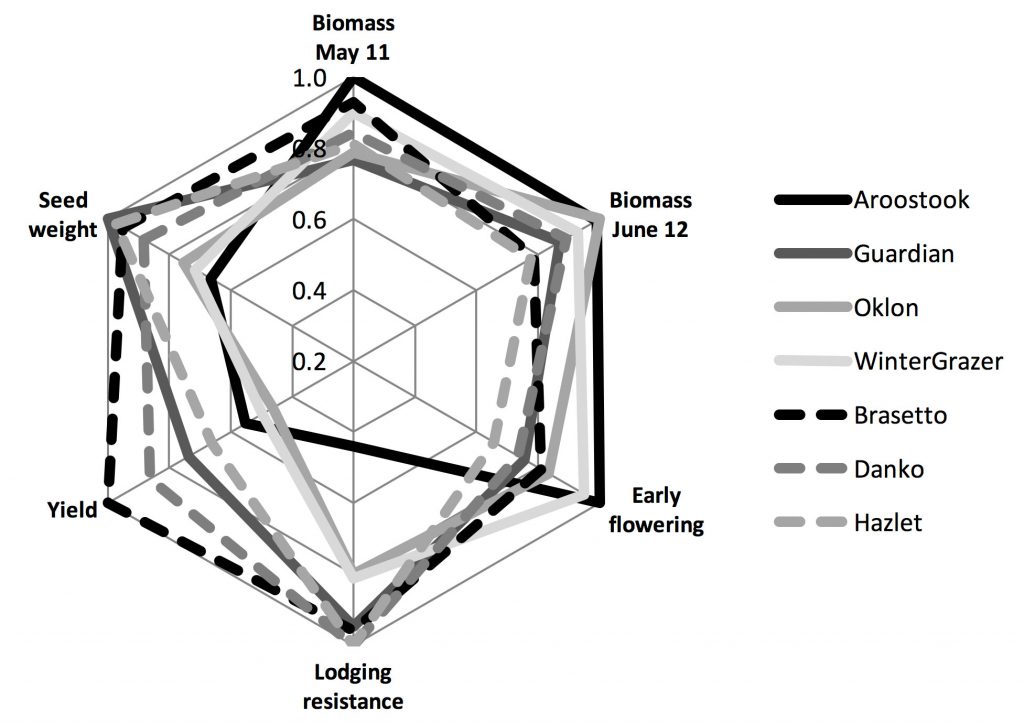Winter Rye Variety Trial 2017 Results
Winter Rye Variety Trial 2017 Results (PDF)
Ellen Mallory and Tom Molloy, University of Maine Cooperative Extension
Winter rye has long been an important cover crop species in Maine, with “Aroostook” as the standard variety. New markets for rye have developed in the region, including seed, flour, and beverage markets. Variety selection is a critical management decision and will depend on what growing conditions, uses, and markets farmers are targeting (see Table 2). Eight winter rye varieties, described in Table 1, were evaluated under drilled and broadcast seeding for their suitability for different uses and markets.
__________
METHODS
The trial was conducted at the University of Maine Rogers Research Farm, in Old Town. The eight varieties were planted using three different treatments: drilled at 1 million seeds per acre with a small plot drill on 6.5” spacing, broadcast at 1 million live seeds per acre, and broadcast at 2 million live seeds per acre. The broadcast treatments were spread by hand followed by shallow rototilling and packing because the soil was extremely dry. These and other agronomic practices are described in Table 3.
| Old Town | |
|---|---|
| Previous Crop | Buckwheat cover crop |
| Soil Type | Nichoville very fine sandy loam |
| Fertility | 20 tons/acre solid dairy manure |
| Planting Date | September 28 |
| Planting Methods and Rates | Drilled at 1 million live seeds/acre Broadcast at 1 million live seeds/acre Broadcast at 2 million live seeds/acre |
| Varieties | See Table 1. |
| Harvest Date | August 2, 2017 |
RESULTS
Seeding Method
Table 4 shows the results of early spring measurements, including plant stands, tiller density, and biomass. In all cases, the performance of the varieties was not influenced by how they were seeded. Therefore, the results for the different varieties are averaged over the seeding methods, and the results for the different seeding methods are averaged over the varieties.
Both the drill seeding and low rate broadcast seeding produced stands close to the target plant density, which was 23 plants per square foot (1 million plants/acre). The target rate for the high rate broadcast treatment was 46 plants per square foot (2 million plants/acre) but only 34 plants per square foot was achieved. We have observed in prior studies that seedling establishment decreases with high seeding rates. Seeding method had no effect on above-ground biomass but interestingly, the broadcast seeded plots produced higher root biomass than drill seeded plots. The only other seeding method effect we saw was higher lodging in the high rate broadcast plots as compared with the low rate plots (Table 5), which presumably was due to the significantly higher tiller density (Table 4).
† ”Tillers” was counted as any stem with three or more leaves and includes the main stem, tillers, and side tillers
• The Midsummer variety was evaluated only with the drill seeding method and so was not included in this statistical analysis.
Variety Performance as a Cover Crop
All varieties provided good stands and similar ground cover in the fall after seeding (data not shown). Winter survival also was good for all of the varieties tested. There were no significant differences among the varieties in terms of spring plant stands. However, some varieties differed in how many tillers they produced. Midsummer and Brasetto produced significantly more tillers than AC Hazlet and Winter Grazer. Note that in this report “tillers” refers to any stem that has three or more leaves. “Tillers” includes the main stem, tillers, and side tillers.
The varieties produced from 1600 to almost 3000 pounds of above-ground biomass by May 11th, when, depending on the year, field preparation for spring crops might begin (Table 4). For the most part, above-ground (or “shoot”) biomass production at this stage was similar among the varieties. The only statistically significant differences were that Aroostook produced substantially higher shoot biomass than Guardian and, in a separate analysis of just the drill seeded treatments, shoot biomass for Aroostook and Brasetto was significantly higher than that for Midsummer.
Root biomass differed more among the varieties than shoot biomass. Aroostook and Winter Grazer, which had relatively high shoot biomass, had among the lowest root biomass. Brasetto, Danko, and AC Hazlet had among the highest root biomass at this stage of growth.
Above-ground biomass is presented again in Figure 1, with two additional dates to show biomass accumulation over time. Although there appear to be differences among the varieties at the May 22 sampling date, we were unable to detect any statistically significant differences due to high variability among the plots. Varieties produced between about 3,000 and 5,000 pounds of above-ground biomass by this date, which is when terminating for summer crops might begin.
Farmers planning to use a roller-crimper to create a dead rye mulch for no-till seeding must wait until the plants are in full flower and shedding pollen to avoid substantial regrowth of the rye. In our trial, Aroostook and Winter Grazer were the earliest to flower, starting on June 6, and Midsummer was the latest, starting on June 12 (Table 4). At this stage, Aroostook and Oklon produced significantly more above-ground biomass than AC Hazlet and Guardian. Other differences among the varieties were insignificant. However, all varieties produced over 6,000-8,000 pounds per acre of above-ground biomass, which is considered the minimum needed to achieve adequate weed suppression in a rye-mulch no-till system (see References).

Variety Performance as a Grain or Seed Crop
As expected, the cover crop and forage type varieties (Aroostook, Guardian, Midsummer, Oklon and Winter Grazer) were the tallest, whereas the grain types (Brasetto, Danko, Hazlet) had the highest grain yields (Table 5). The hybrid Brasetto out yielded all of the others. Aroostook was at the low end for yield and had substantially higher lodging and lower test weights than any of the other varieties.
† 1 = no lodging, 9 = severe lodging
‡ Yield at 13.5% moisture
• The Midsummer variety was evaluated only with the drill seeding method and so was not included in this statistical analysis.

The “star diagram” in Figure 2 summarizes the winter rye variety performance results for three characteristics important for cover crop use (spring biomass, early summer biomass, and flowering date) and three characteristics important for grain production (resistance to lodging, yield, and seed weight). Results are scaled to show the relative performance of the varieties for each characteristic such that the highest value for each measure is expressed as 1.0 and other values are expressed as the fraction of that highest value.
Aroostook, the standard winter rye variety being used in Maine as a cover crop, performed well for the cover crop characteristics but poorly as a grain crop, having the lowest lodging resistance and among the lowest yield and seed weight. These results emphasize the importance for cover crop seed producers to find alternative varieties that perform well for grain production, as well as for use as a cover crop. Guardian, Danko, and Brasetto performed relatively well in all of the measures in Figure 2. Note however that Brasetto is not suitable as a cover crop due to high seed cost.
CONCLUSIONS
- Varieties did not differ in how they performed with drill vs broadcast seeding. However, note that the broadcast seeding method included a light rototilling and packing.
- All varieties produced over 8,000 pounds per acre of above-ground biomass by flowering time, which is considered adequate for weed suppression in no-till roller-crimper systems. However, the later flowering for AC Hazlet and Midsummer make them less suitable for this system.
- Aroostook rye performed well for all cover crop measures but lodged easily and yielded relatively poorly making it a poor choice for grain production. The Aroostook seed for this trial was sourced from a seedbank, while most farmers grow farm-saved seed, but we doubt farm-saved seed would have performed better.
- Brasetto was the top yielding variety, with low lodging, average grain moisture, and good seed and test weight. As a hybrid variety with seed costs 2-3 times greater than standard varieties, it is not well suited for cover crop use but is a good choice for higher-value human-grade grain markets.
- Guardian and Danko were the most “well rounded” of the varieties, performing relatively well for both cover crop and grain characteristics.
- Keep in mind that these are results from just one trial in one year. Seek out additional information before deciding which varieties are best for your farm.
References:
Curren, W., D. Lingenfelter, M. Ryan, D. Sandy, M. Dempsey, and B. Crockett. 2015. Weed Management. In: Penn State Organic Crop Production Guide. pp. 121-150. The Pennsylvania State University, State College, PA. http://agsci.psu.edu/organic/resources/organic-crop-production-guide
Smith, A.N., S.C. Reberg-Horton, G.T. Place, A.D. Meijer, C. Arellano, J.P. Mueller. 2011. Weed Science Vol. 59, Issue 2, pg(s) 224- 231. https://doi.org/10.1614/WS-D-10-00112.1
Updated March 2018
Information in this publication is provided purely for educational purposes. No responsibility is assumed for any problems associated with the use of products or services mentioned. No endorsement of products or companies is intended, nor is criticism of unnamed products or companies implied.
Call 800.287.0274 or TDD 800.287.8957 (in Maine), or 207.581.3188, for information on publications and program offerings from University of Maine Cooperative Extension, or visit extension.umaine.edu.
The University of Maine does not discriminate on the grounds of race, color, religion, sex, sexual orientation, including transgender status and gender expression, national origin, citizenship status, age, disability, genetic information or veteran status in employment, education, and all other programs and activities. The following person has been designated to handle inquiries regarding non-discrimination policies: Director, Office of Equal Opportunity, 101 North Stevens Hall, 207.581.1226.
